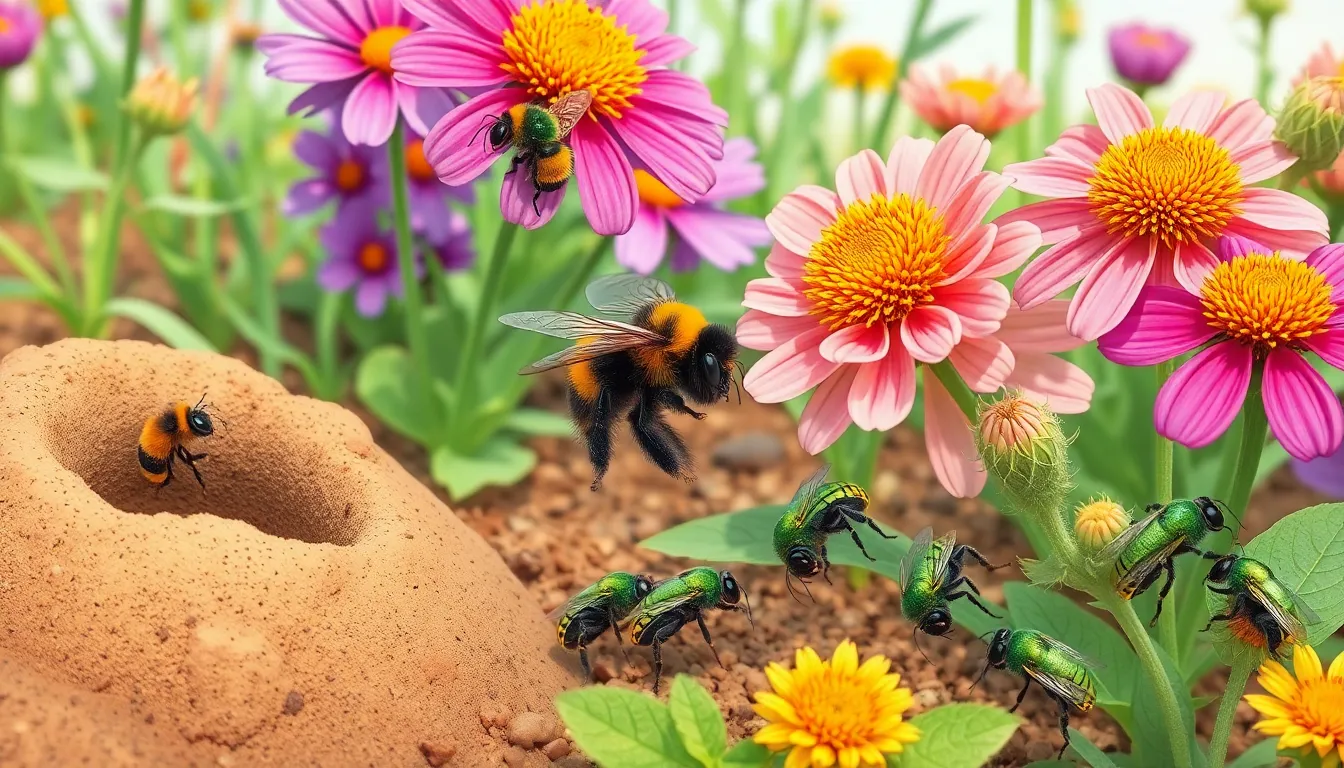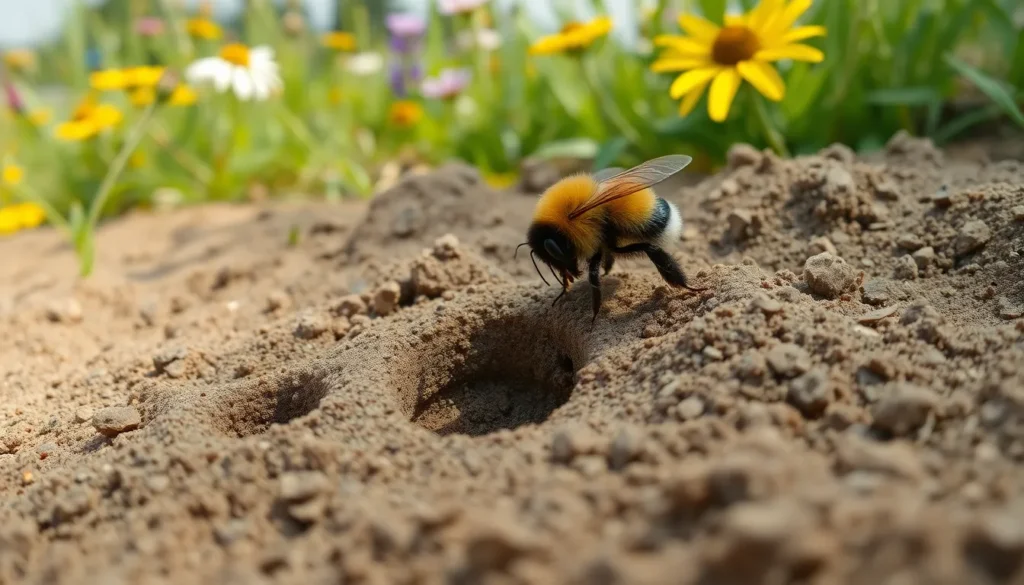Table of Contents
ToggleWhen most people think of bees, they picture buzzing around flowers or hanging out in hives. But did you know that some of these pollinators prefer the cozy digs of the ground? That’s right! Ground-nesting bees are the unsung heroes of the bee world, and they’re not just digging around for fun. They play a crucial role in pollinating our plants and crops.
Overview of Ground-Dwelling Bees
Ground-dwelling bees account for nearly 70% of the world’s bee species. These bees typically nest in the soil, creating individual or communal burrows. They prefer sandy or loose soil, which allows for easier excavation.
Mason bees and mining bees represent common groups of ground-nesting bees. Mason bees build nests in pre-existing cavities, while mining bees dig their own tunnels. Both types provide essential pollination services, benefiting numerous crops and wild plants.
Life cycles vary among ground-dwelling bees. Many emerge in spring, aligning with the blooming of flowers. For instance, some mining bees become active when wildflowers bloom, ensuring they have access to food during their foraging period.
Pollinator efficiency plays a crucial role in their ecological function. Ground-dwelling bees exhibit high visitation rates to flowers, significantly enhancing fruit and seed production. Some studies indicate these bees can increase crop yields by up to 30%.
Habitat preferences influence their distribution. Urban gardens, agricultural fields, and undisturbed lands all serve as suitable environments for ground-dwelling bees. Maintaining diverse plant species in these areas fosters a healthy bee population.
Threats to their survival include habitat loss and pesticide use. Conservation efforts focusing on creating bee-friendly gardens can mitigate these risks. Emphasizing reduced pesticide use and promoting native plant growth enhances their nesting opportunities.
Types of Bees That Live in the Ground

Ground-nesting bees include several species that play crucial roles in pollination. Their nesting habits vary, with specific adaptations for soil.
Mining Bees
Mining bees, belonging to the Andrenidae family, prefer sandy or loose soils. They dig individual burrows, where females lay eggs. Foraging often coincides with flower blooming, maximizing food availability. These bees exhibit solitary behaviors while still congregating in certain areas. Various species of mining bees exist, including Andrena andreniformis, which is particularly common in gardens. High visitation rates help increase crop yields significantly, emphasizing their importance in agricultural settings.
Bumblebees
Bumblebees, classified under the Bombus genus, often choose to nest in underground cavities. They typically utilize abandoned rodent burrows for their colonies. Colonies are seasonal, starting small in spring and expanding as the queen lays more eggs. Females emerge in late summer, so their life cycles align perfectly with blooming plants. These bees’ distinctive yellow and black coloration makes them easily recognizable. Their role in pollination and crop productivity cannot be overstated, as they enhance fruit sets and increase yield by pollinating various crops.
Sweat Bees
Sweat bees, recognized as Halictidae, inhabit areas with exposed soil. Many species are metallic green or blue, adding color to the environment. Solitary nesting behaviors define them, although some exhibit communal nesting. They often prefer disturbed sites, making them adaptable. Unique among their counterparts, sweat bees forage for pollen and nectar from a broad range of flowers. Their economic impact stems from effective pollination, benefiting both wild plants and agricultural crops.
Habitat and Nesting Behavior
Ground-nesting bees thrive in specific soil conditions. Sandy and loose soils provide the ideal environment for these bees to create their nests. Moisture retention in these soils supports egg development. Soil pH often plays a role in nesting, with slightly acidic to neutral soils being the most beneficial. Urban gardens, agricultural fields, and undisturbed areas frequently offer the perfect conditions that encourage these vital pollinators.
Nest construction varies among bee species. Mining bees typically dig individual burrows, with depths ranging from a few inches to several feet. They excavate tunnels in loose soil, using their strong mandibles to navigate and create chambers for eggs. Bumblebees often choose abandoned rodent burrows for nesting, adapting these spaces to suit their colonies. Sweat bees exhibit both solitary and communal nesting, creating nests near one another in suitable terrain. Overall, each species has adapted its nesting behavior to maximize reproductive success and ensure the survival of its young.
Importance of Ground Bees
Ground bees play a vital role in ecosystems, significantly contributing to plant reproduction and biodiversity.
Pollination Contributions
Pollination constitutes one of the most critical functions performed by ground bees. Nearly 70% of the world’s bee species, including various mining and sweat bees, excel in flower visitation. Their high visitation rates lead to enhanced fruit and seed production. Studies show ground bees can increase crop yields by up to 30%. While foraging, these bees transfer pollen from one flower to another, facilitating fertilization. Many crops and wild plants depend on them for reproduction, highlighting their essential role in agriculture and natural habitats.
Ecosystem Roles
Ground bees support ecosystem health in several ways. They promote plant diversity through effective pollination, which helps sustain a variety of flora. This diversity subsequently creates habitats for other organisms, enhancing overall ecosystem resilience. Additionally, ground bees contribute to soil health by aerating it through their nesting activities. Their burrowing behaviors improve water drainage and nutrient circulation within soils. Healthy plants, nurtured by these pollinators, provide food sources for various wildlife, showcasing the interconnectedness of ground bees and ecosystem stability.
Threats to Ground-Dwelling Bees
Ground-dwelling bees face several significant threats that hinder their survival and pollination activities. These threats contribute to declining populations and pose challenges to ecosystem health.
Habitat Loss
Habitat loss presents a crucial danger for ground-nesting bees. Urban development, agricultural expansion, and land use changes lead to the destruction of natural habitats. Contamination and degradation of soil reduce the availability of suitable nesting sites, impacting reproduction. In particular, gardens and fields that lack diverse flora provide insufficient resources, limiting foraging opportunities. Research indicates that nearly 50% of bee habitats have been lost in many regions over the past few decades. Thus, cultivating bee-friendly spaces fosters both survival and ecological balance.
Pesticide Exposure
Pesticide exposure poses an additional threat to ground-dwelling bees. Chemicals used in agriculture can harm bees directly or indirectly, disrupting their foraging and nesting behaviors. Pesticides affect individual bees’ ability to navigate, forage, and reproduce, often leading to population declines. Studies reveal that neonicotinoids, a common pesticide class, significantly impact bee health even at low exposure levels. These harmful effects risk the entire ecosystem, given the pivotal role that bees play in pollination. Advocating for reduced pesticide use and promoting organic farming practices benefits both bees and biodiversity.
Understanding the importance of ground-nesting bees is essential for appreciating their role in our ecosystems. These bees not only enhance plant reproduction but also contribute to soil health through their natural behaviors. With nearly 70% of bee species residing in the ground their conservation is crucial.
As urbanization and pesticide use threaten their habitats it’s vital to support initiatives that promote bee-friendly environments. By fostering awareness and taking action individuals can help protect these indispensable pollinators. The health of our ecosystems depends on their survival and the benefits they bring to both wild and agricultural plants.





